Tropical Flower Care Instructions
For All Tropical Flowers and Foliage:
Unpack carefully and immediately.
Trim ½ to 1 inch off of the stems with a sharp knife or scissors.
Every 3-4 days re-trim stems, clean the vase, and replace the water with fresh.
Occasionally mist flowers (except orchids sprays).
Anthuriums:
Submerge whole flowers in cool water 10-15 minutes.
Keep the flowers away from heat sources and drafts.
Dendrobium and Oncidium Orchid sprays:
Submerge flowers sprays in cool water 10-15 minutes.
Re-cut stems once or twice a week and change water daily.
Keep the flowers away from heat sources and avoid temperatures below 45°F.
Tropicals (Bird of Paradise, Heliconias, Gingers):
For Ginger: Soak the entire flower and stem in cool water for 10-15 minutes.
For Bird of Paradise: To bring out extra flowers, insert your thumb inside the sheath through the slit on the upper side and gently lift up a new flower.
Keep flowers away from heat sources, air conditioning drafts, and direct sunlight.
Foliage:
For Foliage: Trim ½ inch off the stem and immerse immediately in fresh water at room temperature for 15 minutes.
Lei Care Instructions
All Leis:
Unpack carefully and immediately.
Keep fresh leis away from heat sources and avoid temperatures below 45 F.
Store them on the bottom shelf of your refrigerator. (A vegetable bin lined with newspaper works very well). Set your refrigerator on its warmest setting.
Dendrobium Orchid Leis and Loose Orchids:
Mist the leis with fresh water and put them back in the box (or keep wrapped in the plastic covered with newspaper). Store them on the bottom shelf of your refrigerator. Set your refrigerator on its warmest setting.
Vanda Orchid Leis:
Mist the leis with fresh water and put them back in the box, but not in the plastic. Store them on the bottom shelf of your refrigerator. Set your refrigerator on its warmest setting.
Ti-leaf, Song-of-India, Song with Red Ginger Leis:
Mist the leis with fresh water lightly if they look dry, and put them back in the box, but not in the plastic. Store them on the bottom shelf of your refrigerator. Set your refrigerator on its warmest setting.
Set the leis out in the form you would like them to dry in – flat, curved, or hanging.
Maile Leis:
Mist the leis with fresh water and put them back in the box, but not in the plastic. Store them on the bottom shelf of your refrigerator. Set your refrigerator on its warmest setting.
Later, the lei may be dried out and hung up, or the leaves may be used to scent clothing.
Tuberose & Orchid Leis, and Kika Flower Leis:
Do not mist the leis. Place leis back in the box (or keep wrapped in the plastic covered with newspaper). Store them on the bottom shelf of your refrigerator. Set your refrigerator on its warmest setting.
Later, the Kika Flower Lei may be dried out and displayed – it will keep most of its color.
Haku Leis:
Mist the leis with fresh water and put them back in the box. Store them on the bottom shelf of your refrigerator. Set your refrigerator on its warmest setting.
Later, the Many-colored Haku Lei may be dried out and displayed – it will keep most of its color. The Hawaiian custom is to tie a haku lei to a hat, like hat band, and wear the dried lei that way for many years.
A Short History of Hawaiian Leis
Leis in Old Hawaii
The leis of Old Hawaii were made of both semi-permanent materials – hair, bone, ivory, seeds, teeth, feathers, and shells; and the traditional flower and leaf leis – twined vines, seaweed and leaf stems, woven and twisted leaves, strung and bound flowers of every description.
Leis were symbols of love, of a spiritual meaning or connection, of healing, and of respect. There are many references to leis, or as the circle of a lei, being symbolic of the circle of a family, embracing, or love itself:
“Like a living, first-born child is love,
A lei constantly desired and worn.”
(Na Mele Welo, Songs of Our Heritage, (translated by Mary Kawena Pukui), (Honolulu, Bishop Museum Press, Special Publication 88, 1995): Pg 45
Many leis of Old Hawaii had religious and mythological associations. Leis made of the fragrant hala fruit are connected to both love and desire, as well as marking a transition, or passing. Many people will not wear hala-fruit leis, considering them too likely to bring about a change they don’t want, while others will wear nothing else.
We’re often asked about lei customs, especially for weddings, but the most traditional view of leis is to give and wear them for love, honor, respect, or simple enjoyment – chosen on the basis of what is symbolic to you. The traditional, and traditionally-derived leis that we carry are maile, ti-leaf, kukui nut leis, and the rare haku lei made with native flowers (although these are seldom available).
Maile was associated with Laka, the patron spirit of Hula (dance) and other spirits of Old Hawaii. Ti-leaf was (and still is) planted around dwellings to ward off malevolent spirits, stalks of ti were also used as flags of truce and peace. A lei la’i made of two ti-leaves tied at the base and worn open around the neck was worn by priests and physicians.
Leis in Modern Hawaii
Leis have remained a very visible part of island life, incorporating many plants, flowers, and techniques from the many cultures that make up present-day Hawaii. Modern lei-makers have embraced beautiful flowers from all over the world to create leis of lasting quality and beauty. Some of the most common introductions are the many varieties of orchid leis, scented flowers introduced from as far away as Mexico to India, new twining techniques from other areas of Polynesia, new seeds and nuts, and long-lasting flowers such as the Cigar (kika) flower. We now have Japanese-style money leis, Micronesian leaf leis, candy leis, and a vibrant community of people who simply enjoy the creative challenge of lei-making.
Lei-making competitions and demonstrations are common on May 1st (Lei Day in Hawaii), with the competitions often resulting in the dissemination of new techniques and ideas that find their way into the commercial market. The annual Merrie Monarch Hula Competition (April) is also an excellent event to view spectacular leis, and well as any of the the various parades, small-town to Honolulu, held at various times in the islands.
Anthuriums Standards & Buying Tips
Author: Carol Anderson, the owner of Hearts of Hawaii anthurium farm
Standard Sizing for Anthuriums
What are the classes of anthurium sizes? Hawaii Revised Statutes address the standards in a manner that makes it easy to order the best size for your arrangements. Here we paraphrase the “legalese” for classifying the anthuriums.
Fortunately, varieties can be sorted into larger categories ranging from Miniature to Extra Large. Size means the dimension of the flower, determined by averaging the length and width of the flower. Stem lengths are minimums. Our cut flowers start at the minimum length.
- Miniature Class:
Under 3 inches. Some varieties are grown only as miniatures. Stem length from 3 to 7 ½ inches.
Suggestions for use: bridal & bridesmaid bouquets, boutonniere, buttonholes, corsages, hair ornaments, bud vase, small dinner table arrangements.
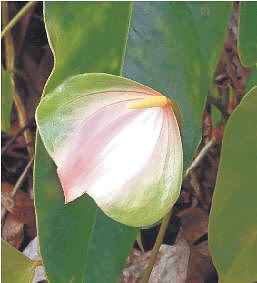
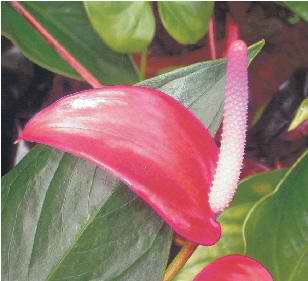
Hawaiian Butterfly and Lady Jane are usually in the miniature to small flower range. - Small Class:
Over 3 and up to 4 inches. Stem length is 4 to 10 inches.
Suggestions: bridal and bridesmaid bouquets, hair ornaments, bud vase, fill in flower arrangements of larger flowers, office desk beautification, banquet table arrangements.
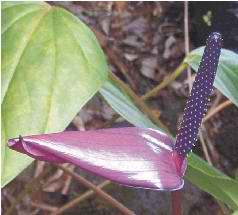
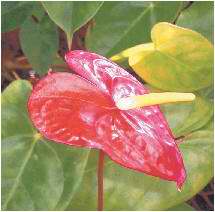
Purple ARCs and Lavender Ladys are usually miniature to small.
Kalapanas range from miniature to extra-large. - Medium Class:
Over 4 and up to 5 inches. Stem length is 5 to 12 ½ inches.
Suggestions: wedding aisle arrangements, fill in with larger flowers, banquet table arrangements, medium vase.
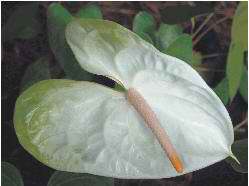
Mauna Kea Obake is medium to large - Large Class:
Over 5 and up to 6 inches. Stem length is 6 to 15 inches.
Suggestions: wedding aisle arrangements, altar arrangements, banquet tables, large vases, anytime you want to impress someone.
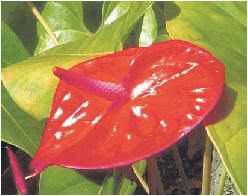
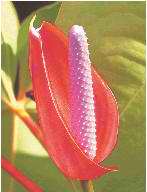
Waimeas range from medium to Extra Large. Calypsos are a tulip anthurium with
long stems in relationship to size which is small to medium. - Extra Large Class:
Over 6 inches. Stem length is 6 to 15 inches.
Suggestions for use: wedding aisle arrangements, altar arrangements, banquet head tables, large vases, great for making a “big splash” of color.
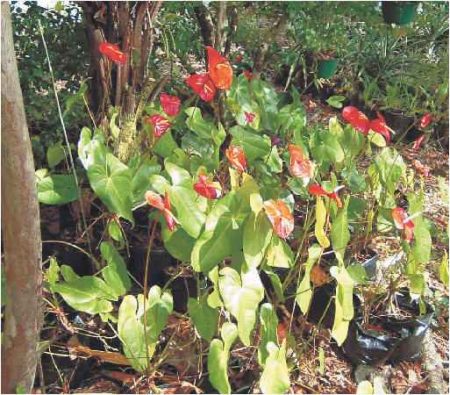
Tropical flower arrangement ideas
Tropical Flower FAQS
-
How do you arrange flowers? For a loose arrangement just clip the ends, place the stems in the vase, pull flowers out and trim a bit here and there until you have a pleasing overall shape – this leaves the flowers available for regular trimming so they stay fresh the longest. A more planned arrangement is achieved by placing the stems one at a time in one hand until you’re happy with the look, tie the stems together, and trim the bottom of the stems even.
-
What are the longest-lasting flowers? Anthuriums will last from 7 to 14 days depending on care and variety. Dendrobium Orchids will last from 5 to 8 days, while Oncidium Orchids will last 7 to 10 days. Tropicals vary widely, but should last up to 5 days for the most delicate, 8 days for the hardier types. All of this depends not only on the flower care in the home, but also the climatic conditions. All tropical flowers need fresh water, misting, and avoidance of heat sources and drafts.
-
What flowers are easiest to arrange? The Orchids are the very easiest, simply place in a vase and they will naturally arch and fill the space beautifully. Anthuriums and Tropicals encourage creativity – they look beautiful just placed in a vase (exactly what our pictures show), or you can get very artistic experimenting with different sizes and placement of stems.
All flower and lei selections are shipped with full Care Instructions.
|
|
|
|
|
25 stems medium oncidium stems |
How to make orchid leis
Single-strung Orchid Leis
How to make the beautiful orchid leis seen on the website.
Supplies:
- # 10 crochet thread (doubled), waxed dental floss, or 10 pound test fishing line
- lei needle, or long needle with medium-sized eye
- 80 dendrobium orchid blossoms
- water mister
- tape measure
- felt-tip pen
Setting up:
Cut a length of thread (doubled) or dental floss (not doubled) 50 inches long.
Mark each end 5 inches from the end with the felt-tip pen. It’s helpful to place
a clip of some sort (I use clothesline pins) at one end.
Thread your needle and…
|
|
||
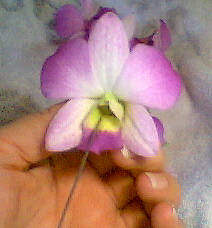 |
Sliding the needle on the ‘lip’ of the flower, pierce the flower about a 3/8-inch below the stub of the stem. | 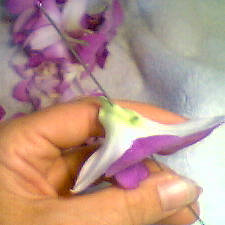 |
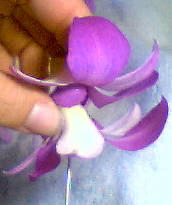 |
Continue adding flowers on the needle, gently nesting the end of each flower into the ‘mouth’ of the next. The line of pierced blossoms should look like a stack of nested hats. Grasp every 4-5 blossoms gently in the palm of your hand and move down to the end of the thread. |
|
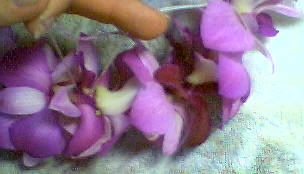 |
String 80 blossoms for a 40″ lei. Finish the lei by nesting the first and last flowers and tying a square knot. Leave a ‘tail’ to carry the lei with until you are ready to present it. |
|
|
Lightly mist each lei as you complete it and store in the vegetable bin (lined with newspaper) of your refrigerator in loose plastic bags. Turn down the refrigerator if you can. |
||
Emergency leis you can make
EMERGENCY LEIS 101
It’s too late to order more leis, what can you do?
DIY FRESH FLOWER LEIS:
Carnations:
String each flower right through the center on a fairly thick thread – try #10 crochet thread, doubled. Strung loose enough that the green bases can be seen uses 30 flowers for a 40″ lei, strung tight enough that the green flower bases are hidden by the next flower uses 50 flowers for a 40″ lei.
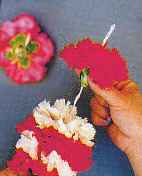

Although they don’t travel well in boxes, carnation leis should last 2-3 days if misted and placed in a bag on the bottom of the refrigerator.
Roses:
Look for spray roses. String the same as for Carnations. It takes 40 flowers for a 40″ lei. Rose leis should last 2-3 days if misted and placed in a bag on the bottom of the refrigerator.

DIY CRAFT LEIS:
Synthetic Raffia:
Simple braided leis made from natural, died, or synthetic raffia are quite pretty! Double the raffia for added thickness and tuck, glue, or sew bows, silk flowers, or craft pom-poms every 4-6 inches.
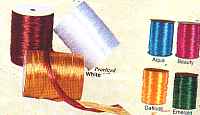
Net Leis:
Many craft stores carry net tubes or netting that can be rolled into a tube shape. Place coins, paper money, or hard candy with knots in between to create a pretty lei – we actually see these every Graduation and Halloween in Hawai’i!

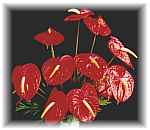
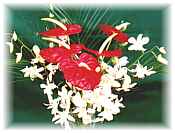
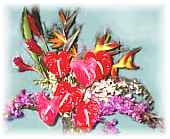
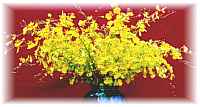
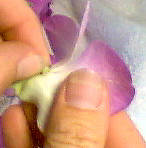
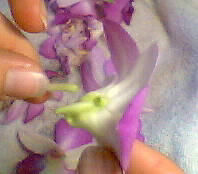 Pluck the stem from each blossom, one at a time or pluck them all before you start.
Pluck the stem from each blossom, one at a time or pluck them all before you start.

